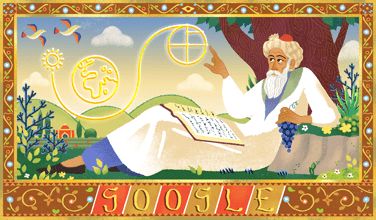Today, May 18, Omar Khayyám’s birthday is celebrated worldwide, maybe more so now that Google produced a ‘doodle’ representing the famous poet-scientist. This novelty was picked up by various news websites and newspapers, all acknowledging the old scientist’s reputation as a man of science, poetry and wisdom.
 The Google search engine provides over 3 million results when you search for ‘Omar Khayyám’, which is rather depressing than motivating to do any further studies on Khayyám. So here is a selection of some recent books on Khayyám and his rubáiyát.
The Google search engine provides over 3 million results when you search for ‘Omar Khayyám’, which is rather depressing than motivating to do any further studies on Khayyám. So here is a selection of some recent books on Khayyám and his rubáiyát.
The Great ‘Umar Khayyám. A Global Reception of the Rubáiyát. A.A. Seyed-Gohrab. Leiden, Leiden University Press, 2012. 267 p. (Iranian Studies Series). ISBN: 9789087281571. [Online available at Open Access]
This volume collects eighteen essays on the history of the reception of ‘Umar Khayyám in various literary traditions, exploring how his philosophy of doubt, carpe diem, hedonism, and in vino veritas has inspired generations of poets, novelists, painters, musicians, calligraphers and film-makers.
FitzGerald’s Rubáiyát of Omar Khayyám. Popularity and Neglect. Edited by Adrian Poole, Christine van Ruymbeke, William H. Martin and Sandra Mason. Anthem Press, 2011.
240 p. ISBN 9780857287816.
This volume of essays is based on a conference held in July 2009 at Trinity College, Cambridge to celebrate the bicentenary of the birth of Edward FitzGerald (1809) and the 150th anniversary of the first publication of his ‘Rubáiyát of Omar Khayyám’ (1859).
The Rubáiyát of Omar Khayyám. An updated bibliography. Jos Coumans. Amsterdam, Leiden University Press, 2010. 250 p. ISBN: 978-908-72-8096-3.
The bibliography lists a new selection and description of more than 1.000 editions of the Rubáiyát of Omar Khayyám.
A book of verse. The biography of the Rubáiyát of Omar Khayyám. Garry Garrard. Stroud, Sutton, 2007. 270 p. ISBN: 978-0-7509-4631-5 (Hardback).
The book tells the story of how The Rubáiyát of Omar Khayyám has provided delight and fascination for centuries.
The Art of Omar Khayyam. Illustrating FitzGerald’s Rubaiyat. William H. Martin & Sandra Mason. London-New York, Tauris, 2007. 184 p. Index. ISBN 978-84511-282-0.
The authors tell the story of the popularity of FitzGerald’s Rubaiyat, and survey how different illustrators have approached the task of interpreting the individual themes and topics of this poem.”
The wine of wisdom. The life, poetry and philosophy of Omar Khayyam. Mehdi Aminrazavi. Oxford, Oneworld Publishing, 2005. 396 p. ISBN: 1-85168-355-0.
Philosopher, mathematician, scientist, and mystic – his many different identities are examined here in detail, creating a coherent picture of this complex and often misunderstood figure.
There are numerous websites on Omar Khayyám as well, but there is one that stands out as a platform for discussion and exchanging information: Omar Khayyam Rubaiyat.
For a more detailed and up to date survey of books and articles see Omar Khayyám.
 Irankultur.com shows a short article about Friedrich Rosen, the well known German translator of Omar Khayyám’s rubáiyát.
Irankultur.com shows a short article about Friedrich Rosen, the well known German translator of Omar Khayyám’s rubáiyát. 

